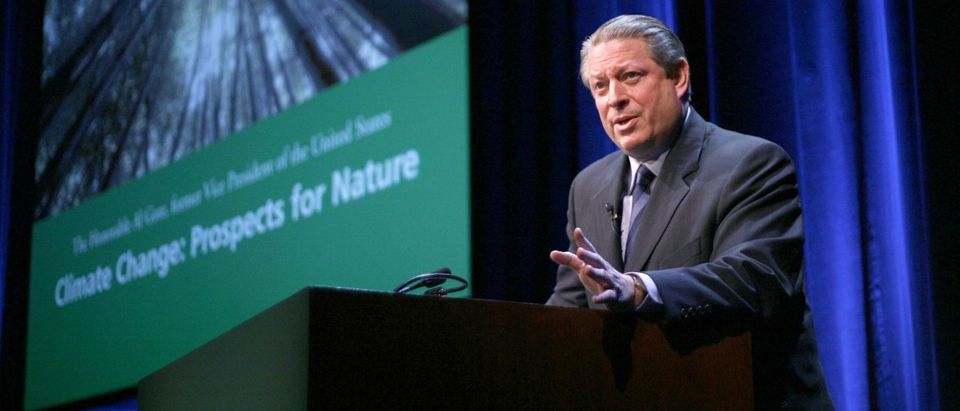Two climate scientists skeptical of man-made global warming are closely watching a study they say could be a “death knell” to climate alarmism.
A major scientific study conducted at the University of Reading on the interactions between aerosols and clouds is much weaker than most climate models assume, meaning the planet could warm way less than predicted.
“Currently, details are few, but apparently the results of a major scientific study on the effects of anthropogenic aerosols on clouds are going to have large implications for climate change projections—substantially lowering future temperature rise expectations,” Cato Institute climate scientists Patrick Michaels and Chip Knappenberger wrote in a recent blog post.
Michaels and Knappenberger, both self-described “lukewarmers,” cited a blog post by Reading scientist Dr. Nicolas Bellouin on the preliminary results of his extensive research into this rather vague area of climate science.
Bellouin wrote “there are reasons to expect that aerosol-cloud interactions are weaker than simulated by climate models – and perhaps even weaker than the preliminary… estimate.”
If Bellouin’s preliminary results hold (or are revised downward), that would mean there’s less of a cooling effect from human-created aerosols interacting with clouds, which morph clouds so they bounce incoming solar energy back into space.
“It may be that aerosol-cloud interactions are lost in the noise of natural variability in cloud properties, but for such a large perturbation, the impacts are surprisingly hard to isolate,” Bellouin wrote.
For decades, scientists assumed aerosols — mostly emitted from coal plants, shipping, car travel and other industrial sources — had a sizable cooling effect on the planet, but that might not be the case. More importantly, however, is the fact that if aerosols don’t have much of a cooling effect, the planet is not as sensitive to increases in greenhouse gas emissions. That means less warming.
“Less enhanced cloud cooling means that greenhouse gases have produced less warming than the climate models have determined,” Michaels and Knappenberger wrote.
“Another way to put it is that this new finding implies that the earth’s climate sensitivity—how much the earth’s surface will warm from a doubling of the pre-industrial atmospheric carbon dioxide concentration—is much below that of the average climate model (3.2°C) and near the low end of the IPCC’s 1.5°C to 4.5°C assessed range,” they added.
Michaels and Knappenberger are particularly interested in Bellouin’s work since it seems to support a study from last year by Bjorn Stevens, a scientist at Germany’s Max Planck Institute for Meteorology. It found aerosols had much less of a cooling effect on the planet than assumed by climate models.
Stevens’s study suggested “that aerosol radiative forcing is less negative and more certain than is commonly believed.”
Independent climate researcher Nick Lewis incorporated Stevens’s findings with his own on how much warming people could expect from doubling atmospheric greenhouse gas concentrations. Lewis found the upper bound estimate of climate sensitivity is from 4.5 degrees to 1.8 degrees Celsius.
In layman’s terms, doubling atmospheric concentrations of CO2 from around 400 parts per million today to 800 ppm in the future would cause 4.5 degrees Celsius of warming, based on Intergovernmental Panel on Climate Change (IPCC) climate model data.
Incorporate the Max Planck study results, and warming would only be as high as 1.8 degrees Celsius — less than half of what IPCC originally predicted.
Of course, Michaels and Knappenberger’s theory is not accepted by everybody. Stevens himself challenged their suggestion that climate sensitivity was lower because aerosols had less of a cooling effect on the planet.
“As they stand, the results of this new study seem to confirm the results of an analysis published last year by Bjorn Stevens of the Max-Planck Institute for Meteorology which also showed a much smaller anthropogenic enhancement of the cooling property of clouds,” Michaels and Knappenberger wrote.
Stevens is entitled to his own opinion, not his own results. And now it seems his research is being supported by Bellouin’s work. With less aerosol cooling, climate models could be tweaked to predict less future warming.
“In the end, aerosol-cloud scientists reckon that it will come down to counting how often clouds happen to show strong sensitivity to aerosol perturbations,” Bellouin wrote. “Those discussions leave me with the feeling that such situations occur infrequently, and radiative forcing of aerosol-cloud interactions may need to be revised down to weaker values.”
Follow Michael on Facebook and Twitter
All content created by the Daily Caller News Foundation, an independent and nonpartisan newswire service, is available without charge to any legitimate news publisher that can provide a large audience. All republished articles must include our logo, our reporter’s byline and their DCNF affiliation. For any questions about our guidelines or partnering with us, please contact licensing@dailycallernewsfoundation.org.


